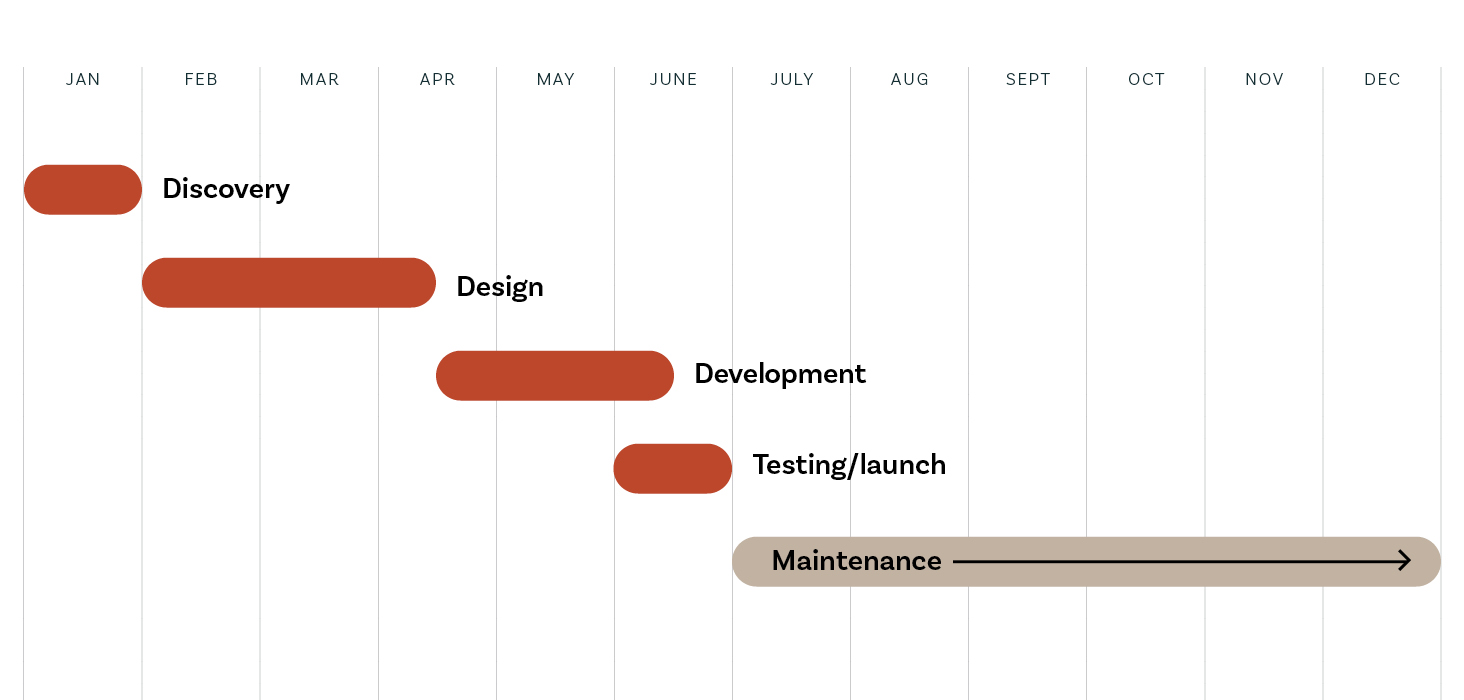Securing approval to redesign your association’s website typically comes down to two questions: How much will this cost and how soon can it launch?
The answers for both questions vary, and they’re ultimately determined by your organization’s needs. But no matter how much you’re planning to spend, website projects require a considerable investment in time and effort — and you have to be realistic about both if you want a new website that will serve your association’s goals.
If your association wants a new website by a specific date, you have to understand what goes into its production. At the same time, you should know what factors impact the time required to generate the kind of website your association needs to be successful.
How Long Does It Take to Create an Association Website?
With so many factors in play, successful websites take time. Most well-executed websites require at least six to nine months to produce. And that’s only after the procurement process is complete and the contract is signed. This means you should get started on your project up to a year in advance of your desired launch date.
Hearing your new website project will take so long to design and develop can be frustrating, especially if you hoped to pair the launch with an upcoming event. But your agency needs a minimum of several months because so much planning and effort goes into creating a website.
Successful association website projects typically incorporate the following:
- Full strategy services: What are your association’s goals for the website? What does your audience need? You and your agency need to answer core questions like these to uncover the best strategy for your new website and how it’s built.
- Messaging: Your website offers members their first impression of your association and sets the standard for how you operate. You need to ensure every element of your site — navigation, design, color, and content — tells a unified and compelling story of your brand.
- Custom design: every page on your site needs a unique design that takes into account the goal of that page and aligns it with your audience and organization.
- Custom development and AMS integration: Features like single sign on, member directory, and integrations with your AMS all take time to develop and test. Similar to custom design, each page of your site needs to be built to load quickly and function as it should.
- Customized CMS: Depending on your current site and your goals, your association may be best served by a platform like WordPress. Tailoring a CMS to suit your publishing needs also requires time and effort.
Although six to nine months is an average timeline to research, strategize, wireframe, design, develop, build, test, and launch a new website, the range isn’t set in stone. There are always plenty of factors that can change your time to launch.
Factors Impacting the Project Timeline for Any Website Project
At the beginning of a project your agency will develop a custom plan and timeline based on your needs and availability.
Sample timeline

The following common factors can potentially increase (or decrease) the time needed to launch a website:
- Changes in scope or your organization’s goals after discovery: Every stakeholder should be informed about the project and its progress to prevent disruptions in the timeline. Sudden shifts in website requirements can easily derail your team’s progress.
- Complexity in custom-designed pages: If your association needs more involved assets like custom illustrations, videos or animations, those take more time to produce.
- Functionality: Complex features such as single-sign-on (SSO) functionality, AMS integration, or searchable libraries for member resources contribute to a longer project timeline.
- Lack of availability of your team or vendors: Successful website projects demand ongoing involvement from your internal team. You need to be an engaged participant to ensure your project stays on schedule. In addition, being proactive in coordinating with outside vendors to secure the assets your project needs will also protect your timeline.
5 Tips to Ensuring Your Association’s Website Launches on Schedule
Member-driven association websites require a strong strategy, user-focused design, and the flexibility to connect with external systems. And very often, that only scratches the surface of what goes into a successful launch.
If your association has a firm deadline for a site launch, you need to be realistic about what’s required. Along with allowing enough time for you and your agency to collaborate, you have plenty of other ways to protect your timeline.
You can protect your project launch date by following the following 5 tips:
- Maintain consistency in communication. Your agency partner depends on your organization to deliver timely feedback about the project. You should appoint a liaison that will prioritize the project and ensure that lines of communication remain open between your organization and the agency.
- Stick to agreed-upon timelines. As your project begins, carefully review the timeline and share any of your concerns. Conflicts such as vacations, events, or major initiatives scheduled at the same time as your website project should be addressed to keep the project on track.
- Be the leader of your team. As the head of marketing or communications, the website is your responsibility. You should take ownership of the project by consistently thinking about the requirements before each project deadline. Whether it’s sending feedback or ensuring it’s consolidated to eliminate conflicting information, you have to ensure your team plays its part.
- Get buy-in from stakeholders early. Identify project stakeholders and engage them in the discovery phase, so they feel heard and aligned with the goals of the project. Additionally, regular check-ins and progress reports can help ensure that everyone is on the same page and that any potential issues or roadblocks are identified and addressed early on.
- Create a list of launch-critical priorities if timing is tight. By considering your most important needs for launch, you can launch with your core priorities addressed and then work toward subsequent improvements post-launch.
Of course, without gathering all the details, your association can’t really know the time required to take your website from where it is now to where it needs to be. If you’re looking to get started, we should talk about the next steps.





